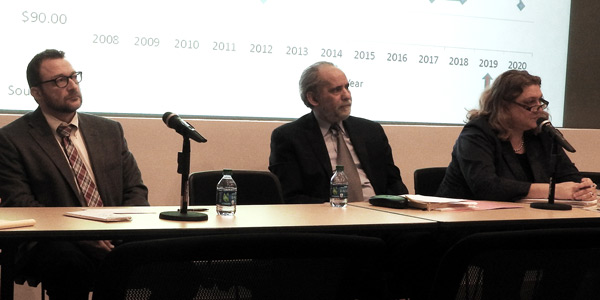By Rory D. Sweeney
NEW BRUNSWICK, N.J. — A panel of experts discussing New Jersey’s energy future agreed Wednesday that the Garden State has made great strides on installing renewable generation resources but differed on whether the progress is sustainable.

“We’re at where we thought we’d be in 2028 [on the state’s renewable portfolio standard], but at a substantial cost,” said Stefanie Brand, the director of New Jersey’s Division of Rate Counsel.
A study commissioned by the rate counsel found that the state’s current solar RPS will cost ratepayers $5.2 billion through 2028 (net present value). A bill proposed last year would ramp up the state’s RPS faster, adding another $276 million (NPV) in costs, the advocate told legislators last year.

Steven Gabel of Gabel Associates, an industry consulting firm, pointed to the “saw-tooth” nature of the clearing prices from recent PJM Base Residual Auctions to argue that the RTO’s price signals “aren’t doing the job” to incentivize generation development. The grid operator’s implementation of Capacity Performance was a “titanic event” to increase reliability, Gabel said, yet clearing prices in the auctions since then have provided ambiguous signals.
Aggregating winter and summer resources won’t solve the issues, either, he said, because the payments go to the resource that gets used instead of being distributed to both.
The discussion was hosted by Rutgers University’s Center for Energy, Economic & Environmental Policy, part of the Edward J. Bloustein School of Planning and Public Policy.

Andrew Hendry, the president of the New Jersey Utilities Association, prognosticated on the state’s potential return to the Regional Greenhouse Gas Initiative following the 2017 gubernatorial election. Republican Gov. Chris Christie pulled the state from RGGI in 2011.
“I think it’s very likely that if a Democrat wins, we’re going to be back in RGGI,” he said.
Gabel said state Sen. Bob Smith, a Democrat who chairs the Environment and Energy Committee, has a “big appetite” and “pent-up demand” for energy reform in the state.
He said state policy has not changed much from the state’s 1980s-era energy plan. “For 32 years, we’ve been talking about it,” he said. “We have to turn this around. … For me, the needle points more toward ‘let the market sort this out.’”
Brand was skeptical of a market-driven focus, saying that’s why the state’s solar renewable energy credits (SRECs) are being sold for $250 when they’re much cheaper in other states. Solar developers are receiving “windfall profits” because “we’re over-incenting,” she said.
New Jersey has the second highest subsidies for rooftop solar, behind California, she said. By comparison, North Carolina and Arizona are growing solar capacity but with subsidies that are “more in line” with other states.
“The fact is I don’t think we need $250 SRECs,” she said. “I don’t buy it. … We get less solar, not more.”
Gabel said that’s what the market will bear. “We moved away from an administrative structure for SRECs to a market.”
Brand cautioned that it won’t be long before ratepayers can’t afford to purchase electricity. “Our prices are high and they’re very volatile,” she said. “Not all good things deserve a subsidy.”
She included nuclear in that, noting that PJM’s analysis on Artificial Island’s three reactors found that Delaware stands to receive the most benefit from planned transmission upgrades for the nuclear complex. “Much of the electricity that comes out of these plants doesn’t go to New Jersey,” she said. “Before we subsidize these plants, we have to figure out if we’re subsidizing Delaware.”

The Garden State remains heavily dependent upon its nuclear fleet, receiving 56% of its power from such sources, she acknowledged. “I don’t think we’ll see any offshore wind in the immediate short term,” she added.
Hendry said that data analytics will be an important part of the state’s energy future, but Brand argued that advanced meters aren’t helping consumers. “The primary benefit you get in advanced meters is lost jobs” because companies need to employ less people as meter readers, she said.
“We cannot afford to give everybody net metering” because it reduces the number of customers who pay for social-benefit charges, like low-income subsidies, she said. “We have to make sure everybody has access to heat, electricity. … Everybody has to pay their own way.”
She also questioned the FERC-approved rate adder utilities get for joining PJM: “At this point, it’s a free 50 basis points.”


